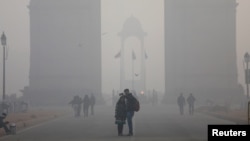The most recent air pollution data from the World Health Organization gives India a dubious lead. The world’s 10 most polluted cities are Indian.
The air quality database for 2016 was released by WHO on Wednesday and showed that the north Indian industrial city of Kanpur had the highest measured levels of PM2.5, or small particulate matter.
Kanpur, a northern city on the banks of the Yamuna River, recorded an annual average PM2.5 level of 173 micrograms per cubic meter, several times higher than the WHO recommendation of no more than 10 mcg per cubic meter.
New Delhi joined by other cities
India’s capital, which once was the world’s most polluted city, ranks sixth in the most recent list. But experts say the data does not show improvements in New Delhi’s air quality, but rather that more Indian cities have toxic air.
“This is a grim reminder that air pollution has become a national public health crisis. It requires hard action,” Anumita Roy Chowdhury, executive director of the Centre for Science and Environment, a Delhi-based research and lobbying organization, said in a statement.
WHO says as many as 9 out of 10 people across the world breathe unhealthy air. It attributes some 7 million deaths yearly to air pollution as tiny particulate matter lodge deep inside the lungs, causing strokes, heart diseases, lung cancer, chronic obstructive pulmonary diseases and respiratory infections.
The Indian capital and large parts of north India gasp for breath for most of the year due to vehicle fumes and swirling construction dust as well as coal and garbage fires lit by the poor to keep warm.
Some local studies indicate up to a third of Delhi’s children have impaired lung function and respiratory diseases like asthma.
Struggling to clear the air
Since being identified as one of the world’s most polluted cities, the Indian capital has struggled to clean its air.
It has barred cargo trucks from city streets, required drivers to buy newer cars that meet higher emissions standards and experimented at limiting the number of cars on the road. But other pollution sources, including construction dust and the burning of crop stubble in the winter, continue unchecked.









